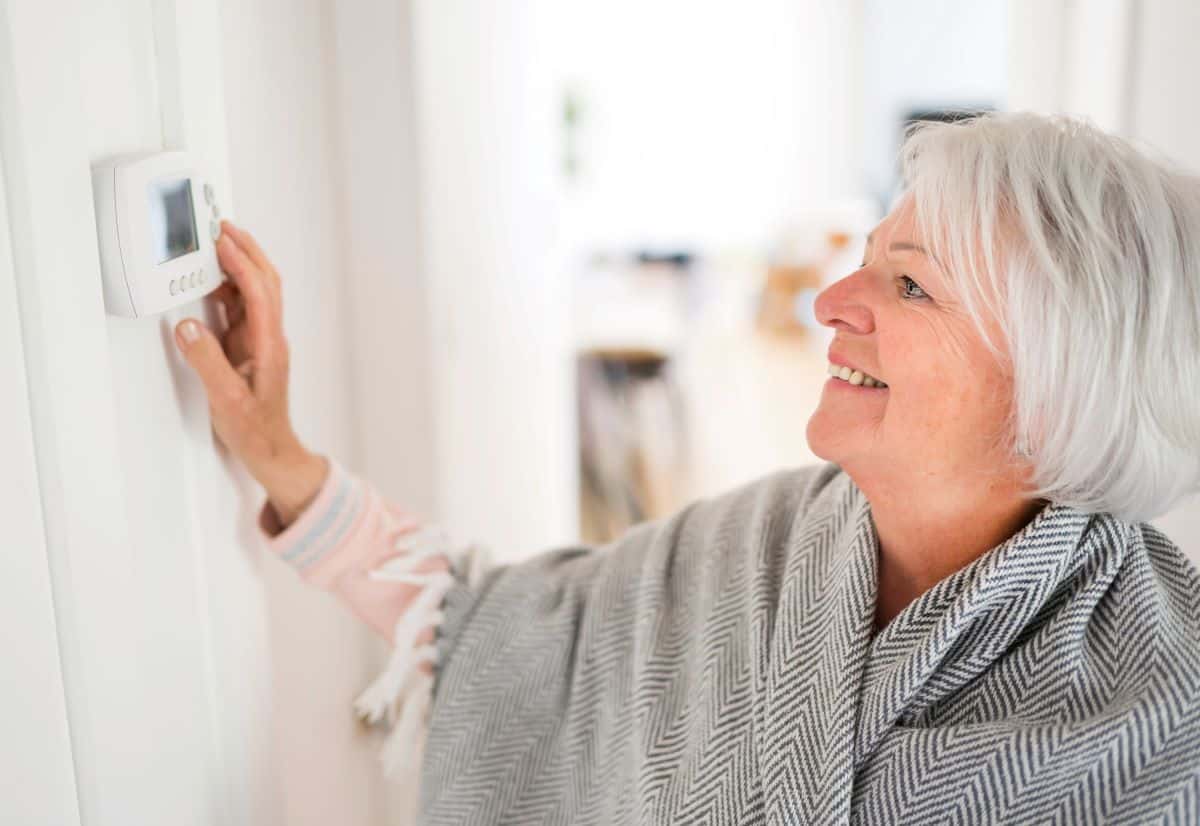Key Points
-
Home adaptations, electronic security, and wearable safety devices provide safety and security for seniors at home.
-
Most older adults say they want to live in their homes as they age.
-
Aging at home is possible with the best home safety tips for senior citizens in 2023.
-
The best home safety tips for senior citizens help minimize common safety risks such as falls, burns, and accidents.
Many seniors want to age in their own homes but must manage the accompanying safety risks. The best home safety tips for senior citizens in 2023 show you how to make your home a place where you can feel secure.
The best home safety tips for senior citizens in 2023 include home adaptations, electronic safety devices, and wearable safety devices that travel anywhere.
Follow these simple tips to enjoy your senior years at home safely.
Do You Want To Age in Place?
Aging in place stands out as one of seniors’ most frequent wishes. 77 percent of adults over 50 want to remain in their homes long-term.
Many people desire the comfort, autonomy, and privacy of living in their own homes. Aging at home also allows you to avoid the cost of an assisted living facility.
Remaining in your home as you age presents challenges, however. Your home might not cater to your needs, so getting around grows difficult and unsafe. Cleaning and maintaining a home becomes more complex with age, and many people feel isolated. Plus, it’s hard to find qualified or affordable assistance when needed.
Only one in three middle-aged and older people say their home has the features they need to age in place.
"So many older adults want to be able to stay at home for as long as possible, but it just doesn't seem as though most are really thoughtful about what that means and the sorts of ways in which they have to prepare," said Dr. Sheria Robinson-Lane, an assistant professor with the University of Michigan School of Nursing.
Common Home Safety Risks for Seniors
Seniors face many common risks living at home as they grow older. Unfortunately, these risks can lead to hospitalization or nursing care, which you want to avoid at all costs.
Consider these common safety risks when you want to remain independent as you age.
Falls
Falls are — without a doubt — the most common and costly mishap among seniors who live alone in their homes. More than one in four adults over 65 falls annually, and most incidents happen at home.
"Falls are a big area of concern for us," says Ramsey Alwin, president, and CEO of the National Council on Aging. "Last year alone, there were more than 3 million injuries related to falls, and that resulted in over 800,000 hospitalizations."
Your risk of falling increases as you age due to decreased balance and coordination. Deteriorating muscle mass, vision problems, and medication side effects also play a role.
Medication-Related Problems
Older adults may take multiple medications, which increases the risk of adverse reactions and interactions. With daily doses required, it’s easy to miss one or take it twice. Plus, some medications cause drowsiness or disturb your balance, increasing your risk of falling.
Cognitive Impairment
About 40 percent of people aged 65 or older have age-associated memory impairment — in the United States, that’s about 16 million people. Dementia and other cognitive impairments make remembering essential safety precautions or recognizing potential dangers difficult.
Fire Hazards
After age 65, your risk of injury or death by fire doubles. Home adaptation and careful habits reduce your risk of accidental fires due to smoking, kitchen fires, heating fires, electrical malfunctions, burning, and burning candles.
Ensure you have working smoke detectors with fresh batteries in all cooking and sleeping areas.
Driving
Many seniors live in homes without nearby public transportation or prefer to drive their own vehicles. Physical changes like stiffness, reduced sight and hearing, slower reaction time, medications, and illnesses contribute to unsafe driving practices.
Elder Abuse
Unfortunately, elder abuse is common. Older adults are vulnerable to physical, emotional, or even financial abuse by caregivers or family members. Many cases go unreported because elders are afraid or unable to tell police, friends, or family about the violence.
Victims must make a difficult decision on whether to tell someone that a person they depend upon or care for deeply is hurting them.
Home Adaptations
Most homes don’t adapt to your needs as you age. If you have steps to your entryway, a second-floor bedroom, or bathrooms and doorways too narrow for a mobility device, you may have to look for someplace else to live.
Adapting your home to suit your needs is often better than moving. You can stay in the neighborhood you love and near your accustomed services. Home safety and adaptability measures reduce your risk of fall-induced injuries.
Follow these tips to make your home safer for your senior years.
Remove Hazards
Start by identifying any potential hazards in the home, such as loose rugs, cluttered pathways, or tables with sharp corners. You might need to remove some furniture to create wider pathways throughout your home.
Secure or remove area rugs and ensure that transitions between flooring are flat and smooth. Remove clutter from the floor, seating, and tabletops since excessive items can cause you to fall.
Install Grab Bars and Handrails
Use grab bars and handrails in your bathroom, shower, and stairs to provide support in high-risk areas. Follow installation instructions carefully and use the appropriate hardware — if you are unsure, hire a professional.
Consider placing a security pole next to your bed to help you get up and lie down.
Improve the Lighting
As you age, your eyes don’t let in as much light. Increase the brightness of your home lighting — especially in areas like stairs, hallways, and bathrooms.
Ensure you have switches that turn on and off at the top and bottom of the stairs for maximum safety. Flat decor switches or motion-activated switches are easier for arthritic hands to use.
Make Adjustments in Your Bathroom
Many falls occur in the bathroom or shower, so pay special attention to this space. Consider installing a walk-in shower or tub to eliminate stepping over a high ledge, and add non-slip mats or strips in the shower or bathtub and near the sink to prevent falls.
Choose a non-slip flooring material, and set your water heater to a scald-safe 120 degrees.
Modify Your Kitchen
Your kitchen is the hardest working room in the house, but preparing healthy meals is more challenging as you age. Adapt your kitchen with pull-out shelves and use contrasting colors on countertops, floors, and appliances.
Install anti-slip flooring and easy-to-grip D-shaped handles on cabinets and drawers. Consider using adaptive tableware for convenient meals.
Organize Your Home
When storing items, make sure everything has its own place so you can remember where to find the things you need. Consider using labels for easy identification. Ensure essential items such as your keys, wallets, medications, mobility aids, and glasses are visible and easy to access.
If you don’t need an item regularly, place it in a see-through, labeled container so you can find it easily. Sort and store essential documents — like medical information, insurance, and tax returns — in one safe place.
Store your frequently used items between hip and shoulder height to avoid bending or reaching.
Technology Assisted Safety
One of the best new tools for seniors who live independently is technology. You might feel daunted by the prospects of mastering new technology, but safety products for seniors are simple to operate and address your most common safety concerns.
Home Security Systems
A home security system can help you feel safer by providing 24/7 monitoring and alerts for potential intruders. They also include motion sensors and door alarms to detect unusual activity. Some home security systems also allow you to call for help by pushing a button.
Smart Home Technology
Smart home technology controls the aspects of your home you choose, such as lighting, temperature, and security. You can even use simple voice-activated assistants like Amazon's Alexa or Google Home to control these devices, a more straightforward approach if you have mobility issues or reduced vision.
Video Monitoring Systems
Video monitoring systems allow someone you love and trust who's at another location to watch you when you live alone. These systems include cameras placed around the home and have remote access via a smartphone or tablet.
Wearable Safety
If you’re still active outside your home regularly, you might want a safety device that travels with you. Wearable safety devices come in wristbands, necklaces, or clips.
They allow you to summon help from any place and may even call emergency services if you fall or become unconscious.
Here are some examples of wearable safety devices for seniors.
Personal Emergency Response Systems (PERS)
These wearable devices allow seniors to call for help in an emergency. PERS are available as a necklace or bracelet and include a call button that alerts a monitoring center or designated caregiver.
GPS Tracking Devices
GPS tracking devices monitor the location of seniors and are particularly helpful for those with dementia or Alzheimer's disease who may be prone to wandering. Wear a tracking device as a watch or attach it to clothing or a bag.
Fall Detection Devices
Fall detection devices detect when you have fallen and automatically alert your designated caregiver or emergency services. Many devices also include GPS tracking technology to provide your location.
Smartwatches
A properly equipped smartwatch monitors your health metrics, such as heart rate, blood pressure, and sleep quality. It can also provide medication reminders, track activity levels, and receive notifications from family members or caregivers.
Insole Sensors
Placed inside your shoes, insole sensors monitor walking patterns and detect changes that may indicate a fall risk. These sensors alert caregivers or family members if your walking pattern changes.
Home Safety for Seniors With Dementia
If you have dementia, you may need additional safety devices to ensure your well-being and prevent wandering. These safety devices are beneficial for seniors with dementia:
-
GPS tracking devices: GPS tracking devices can monitor your location if you have dementia and are prone to wandering. Caregivers or family members use a mobile app to monitor your location and receive alerts if you leave a designated safe area.
-
Door alarms: Door alarms on exterior doors alert your caregivers or family members when you open the door. These alarms have an audible alert or send a notification to a mobile device.
-
Motion sensors: These helpful products detect movement and alert caregivers or family members if you get up at night or wander into an off-limits area.
-
Medication reminders: If you have dementia, you may have difficulty remembering to take your medications on time. Medication reminder devices sound an alert when it’s time to take your medicine, or they automatically dispense it.
-
Personal emergency response systems (PERS): PERS devices can be handy for seniors with dementia who may become confused or disoriented. A PERS device allows you to call for help in an emergency by pressing a button on a wearable device.
Make Your Home a Safer Place
Your home is your haven, and you want to stay there as you age. Home safety tips like brighter lighting, non-slip floors, and easy-to-reach shelves make your home senior-friendly.
Add the latest electronic home security, and pack a wearable safety device when on the go. These up-to-date tools give you peace of mind that help is available when needed.
Follow GoldYears for more great tips on safety for seniors.









